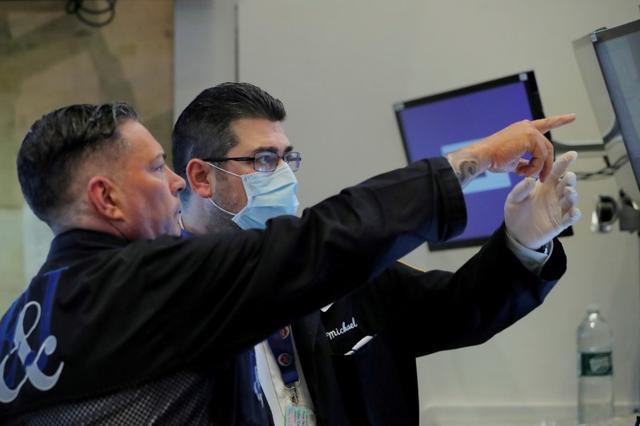LONDON/BOSTON: Central banks have offered trillions of dollars of support to markets in recent days to keep them from freezing up, as investors worried about the economic damage from the coronavirus and made a chaotic dash for the exits.
While the intervention helped bring back some order to markets, policymakers may need to do more.
Investors, economists and bank strategists said they expect policymakers will have to step in with more support in the coming days to prop up both markets and the real economy – companies losing customers and workers thrown out of jobs.
There is a limit for now to how effective authorities can be, however, some said. Before investors calm down, these observers said, they will need to see a peak in new virus infection rates, an improvement in hospitals’ ability to cope with an influx of patients, and an end in sight to the economy-killing quarantines, travel bans and other restrictions being imposed to save lives.
“The best that economic and financial policymakers can do right now is limit the damage. They cannot turn the economy around because this is a health issue, not an economic or financial issue,” said Mohamed El-Erian, chief economic advisor to the German insurer Allianz SE, in an interview.
Estimates of the sums required to keep Corporate America afloat are reaching eye-popping levels. Ray Dalio, founder of hedge fund giant Bridgewater Associates LP, estimates the financial losses for US companies from the coronavirus-induced slump could be about $4 trillion. That’s nearly one-fifth the value of America’s total economic output last year. The government will have to come to the rescue, Dalio told Reuters via email, backed by a central bank that prints money.
“What needs to happen is very similar to what happened in the war years, but without the fighting,” Dalio said.
Governments ramped up their support quickly in recent days as it became clear that the scale of the hit from the virus is likely to be huge. Last week was the worst since 2008 for the U.S. stock market. Less visible is the stress building up in other markets that keep the real economy humming, such as the markets where companies go to raise short term cash to pay staff and where cities go to raise money for roads and schools. Many central bank measures have been aimed at reducing the strain in those areas.
These steps have ranged from slashing interest rates and ramping up bond buying programs to the Federal Reserve’s resurrection of funding facilities from the financial-crisis era. These steps have eased the strain, but analysts and investors said they didn’t go far enough, and new areas of concern have emerged.
One success: The Fed has made it easier for other nations’ central banks to obtain dollars to meet runaway global demand for the greenback. As the Fed acted, a key measure of the premium investors pay to access the U.S. currency fell to its lowest level since March 3. The measure, known as the euro-dollar EURCBS3M=ICAP swap spread, fell to less than 4 basis points, or 0.04pc, on Friday after going as wide as 86 basis points on Monday. But in a sign that the thirst for dollars globally remained unsatiated, the US currency remained strong.
A spokesman for the Fed declined to comment on a request sent Sunday evening.
Traders also complained during the week about problems trading US government bonds and other kinds of debt amid large price swings. There has been a shortage of buyers despite the Fed providing more funding and purchasing some types of assets. Yields continued to rise in municipal debt markets, for example, where the Fed’s support was limited to short-term debt and highly rated issuers. Yields rise when bond prices fall.
In commercial paper markets, where companies go to access short-term funding, the Fed launched on Tuesday a new facility that buys commercial paper from highly rated companies. It helped, said Blake Gwinn, a strategist at NatWest Markets Plc, but the borrowing costs were higher than expected and the facility was too limited in targeting the strongest borrowers.
In a research note Friday, he wrote that without significant changes, the program “would not do much to unclog” the commercial paper market. Gwinn, a former trader for the New York Federal Reserve, said the central bank should become a direct buyer of clogged assets, rather than “merely providing funding and hoping” that banks and other players will do the heavy lifting.
Some analysts and industry sources argued for loosening of bank regulations which, in their view, are restricting liquidity – the ability to easily buy and sell assets. Suspending these rules, they argue, will make it easier for banks to step in as market makers and lenders in a bigger way.
“The next crucial step in aiding liquidity will be to ease bank regulatory constraints,” TD Securities strategists wrote in a note.
HIGH VOLATILITY
One sign that the measures so far are insufficient: persistent volatility in markets. Volatility – large ups and downs in asset prices – is at extreme levels, as measured through indicators such as the market fear gauge in stocks and the Deutsche Bank Currency Volatility Index DBCVIX in currencies.
High levels of volatility have forced funds and banks to sell their positions or step back from market-making, the all-important role of go-between in big trades, as they try to keep the amount of risk in their portfolios in check, bank strategists said. That, in turn, has led to more sellers than buyers, resulting in gaps between bid and offer prices of assets, which exacerbates market volatility.
Some of the measures taken by the Fed – such as buying bonds and lending money to banks so they can step in as buyers for some of these assets – are aimed at ending that logjam. But these steps have not managed to soothe the markets.
One example is the market for Treasury bonds, one of the world’s most liquid assets. Prices continued swinging sharply last week. In normal times, Treasury yields move a few basis points, or hundredths of a per cent. The 10-year Treasury US10YT=RR saw a 43-basis-point swing in yield on Friday, versus a swing of about 27 points on Wednesday and Thursday.
Another concern for central banks that is gaining more urgency: corporate credit.
US and European corporate debt markets have seized up, with markets for new issuance of bonds virtually shut and spreads spiking in secondary markets. The costs that companies pay to borrow in bond markets have surged to multi-year highs and remain highly elevated despite the central bank moves. Adding to the stress, ratings agencies have started downgrading companies as the revenue squeeze gets worse.
Allianz’s El-Erian said he suspected that a coordinated U.S. Treasury and Fed attempt is in the works to counter market failures in areas US authorities have not yet targeted, such as the market for corporate credit. That intervention, he predicted, would be made “over the next few days, not even weeks.”
























